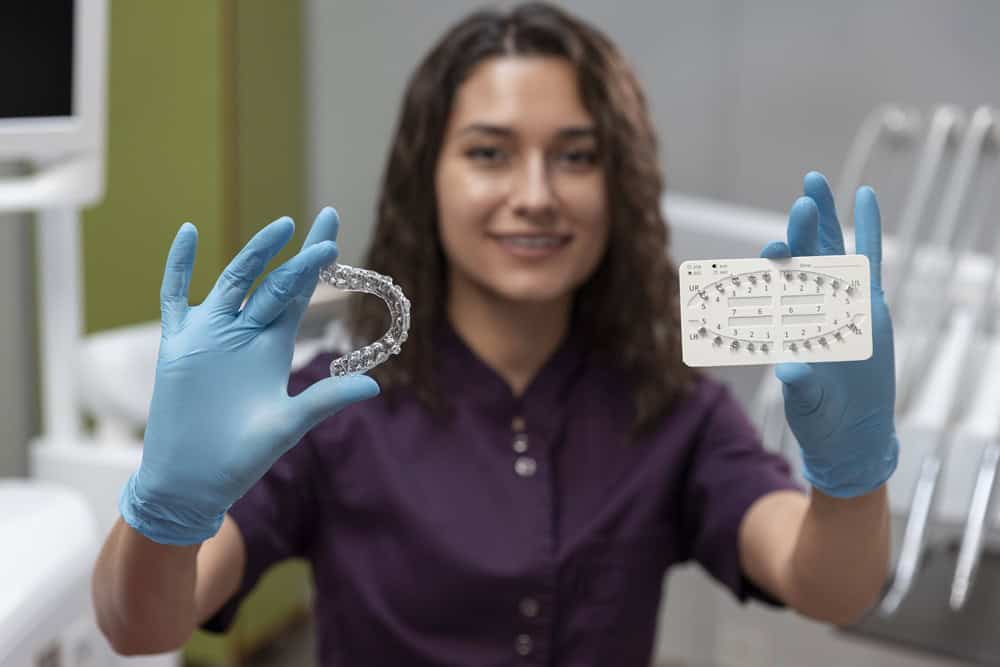Invisalign is a well-known way to straighten teeth using clear, removable trays. However, some patients experience loose teeth during their Invisalign treatment. If you’re one of them, don’t panic. This blog will explain why this happens, whether it’s normal, and what you can do about it.
What is Invisalign?
Invisalign is an orthodontic treatment that uses a series of custom-made, clear plastic aligners to move teeth into their desired positions. When you consider Invisalign near you, they need to be replaced every one to two weeks, gradually shifting your teeth over time. Unlike traditional braces, Invisalign aligners can be removed, making eating, brushing your teeth, and flossing easier.
Why Teeth May Feel Loose During Invisalign Treatment
Feeling your teeth become loose during Invisalign treatment can be concerning, but it’s often a normal part of the process. Here’s why it happens:
1. Bone Remodeling
When your teeth move, the bone around them needs to change to accommodate their new positions. This process is called bone remodeling. As your teeth shift, bone breaks down in some areas and builds up in others. During this transition, your teeth may feel loose.
2. Ligament Stretching
Teeth are connected to the jawbone by periodontal ligaments. These ligaments stretch as your teeth move, making them feel loose. This temporary stretching generally resolves once your teeth settle into their new positions.
3. Normal Movement
During the initial stages of Invisalign treatment, it’s common for teeth to feel slightly loose as they begin to move. This sensation usually diminishes as you progress through your treatment and your teeth become more stable.
Smile Confidently with Prairie Pines Dental
Book an Appointment
Is It Normal for Teeth to Feel Loose During Invisalign Treatment?
Yes, it’s normal for teeth to feel a bit loose during Invisalign treatment. This feeling is usually temporary and should subside as your treatment progresses. However, if you’re concerned or if the looseness persists, it’s important to consult your orthodontist.
What to Do If Your Teeth Feel Loose
1. Stay Calm
Remember that some looseness is normal and part of the process. Panicking can cause unnecessary stress and anxiety.
2. Follow Your Orthodontist’s Instructions
Your dentist Invisalign, will provide specific instructions for wearing your aligners and caring for your teeth. Follow these guidelines closely to ensure your treatment progresses smoothly.
3. Avoid Hard or Sticky Foods
Eating hard or sticky foods can put extra pressure on your teeth, making them feel even looser. Stick to softer foods and avoid chewing gum to reduce discomfort.
4. Maintain Good Oral Hygiene
Keeping your teeth and gums clean is crucial during Invisalign treatment. Brush and floss regularly to prevent plaque buildup and gum disease, which can contribute to tooth mobility.
5. Wear Your Aligners as Directed
Wearing your aligners for the recommended 20-22 hours daily is essential for effective treatment. Removing them too often can slow progress and make your teeth feel more unstable.
6. Communicate with Your Orthodontist
If your teeth feel excessively loose or if you experience pain, contact your orthodontist. They can assess your situation and make any necessary adjustments to your treatment plan.
Potential Risks and Complications If You Don’t Address Loose Tooth During Invisalign Treatment
- Gum disease: If you neglect your oral hygiene, you could develop gum disease, which can cause your teeth to become loose. Regular brushing, flossing, and dental checkups are essential to prevent this.
- Tooth mobility: Excessive tooth mobility can lead to discomfort and may require adjustments to your treatment plan. Your orthodontist can monitor your progress and make changes as needed.
- Bone loss: In rare cases, bone loss can occur if the pressure from the aligners is too great. This is why following your orthodontist’s instructions and attending all scheduled appointments is crucial.
Tips for a Successful Invisalign Treatment
- Stick to the schedule: Wear aligners as directed and change them on schedule.
- Practice good oral hygiene: Brush and floss after every meal to prevent gum disease and maintain stability.
- Avoid certain foods: Avoid hard, crunchy, and sticky foods to protect your aligners and teeth.
- Attend regular checkups: Visit your orthodontist regularly to monitor progress and make adjustments.
- Use chewies: Use chewies to seat aligners properly and ensure effective tooth movement.
- Be patient: Trust the process and follow your orthodontist’s advice for a beautiful, straight smile
When to Seek Help
While some tooth looseness is normal, there are times when you should seek help from your orthodontist:
1. Excessive Pain
If you’re experiencing significant pain that doesn’t go away, contact your orthodontist. This could indicate a problem with your treatment.
2. Persistent Looseness
If your teeth feel excessively loose for an extended period, schedule an appointment with your orthodontist. They can assess your situation and make any necessary adjustments.
3. Signs of Gum Disease
When your gums are red, puffy, or bleed easily, it might mean you have gum disease. If you notice these symptoms, seek professional help to prevent further complications.
Feeling loose teeth during Invisalign treatment is a common and normal part of the process. Understanding why this happens and how to manage it can ensure a smooth and successful journey toward a straighter smile. Always follow your orthodontist’s Invisalign care instructions, maintain good oral hygiene, and stay patient throughout your treatment.
Schedule Your Consultation Today!
If you’re experiencing loose teeth or have any concerns about your orthodontic care, don’t hesitate to reach out to us. Visit Prairie Pines Dental and let us help you achieve the smile of your dreams. Our experienced team of dentist in Prince Albert is here to support you through every step of your Invisalign treatment.
